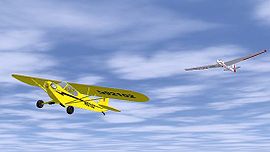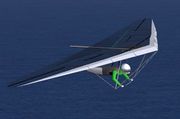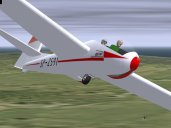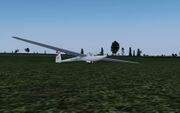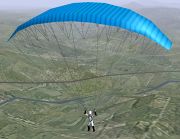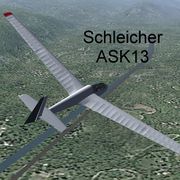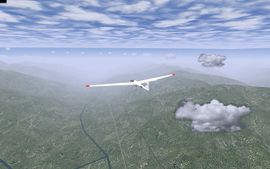Soaring: Difference between revisions
(Dragonfly is NOT a glider, sort gliders on name, use cite web template.) |
m (Fix gallery) |
||
| Line 1: | Line 1: | ||
[[File:Aerotow2.jpg|thumb|270px|[[Bocian]] being towed by a [[Piper J3 Cub]].]] | [[File:Aerotow2.jpg|thumb|270px|[[Bocian]] being towed by a [[Piper J3 Cub]].]] | ||
'''Gliding''' or '''soaring''' is a recreational activity and competitive air sport in which pilots fly unpowered [[aircraft]] known as gliders or sailplanes using naturally occurring currents of rising air in the atmosphere to remain airborne.<ref>{{cite web |url=http://en.wikipedia.org/wiki/Gliding |title=Gliding |work=Wikipedia }}</ref> | '''Gliding''' or '''soaring''' is a recreational activity and competitive air sport in which pilots fly unpowered [[aircraft]] known as gliders or sailplanes using naturally occurring currents of rising air in the atmosphere to remain airborne.<ref>{{cite web |url=http://en.wikipedia.org/wiki/Gliding |title=Gliding |work=Wikipedia }}</ref> | ||
| Line 6: | Line 5: | ||
[[FlightGear]] has several glider models and winch, AI aerotow or [[Doing aerotow over the net|MP aerotow]] launching methods (in addition to the normal "in-air start" method). | [[FlightGear]] has several glider models and winch, AI aerotow or [[Doing aerotow over the net|MP aerotow]] launching methods (in addition to the normal "in-air start" method). | ||
{{Gallery| | {{Gallery | ||
[[Airwave Xtreme 150]]| | |AirwaveXtreme150.jpg|[[Airwave Xtreme 150]] | ||
[[SZD-9bis Bocian-1E|Bocian]]| | |Bocian.jpg|[[SZD-9bis Bocian-1E|Bocian]] | ||
[[Glaser-Dirks DG-101G]]|DG- | |DG-101G_001.jpg|[[Glaser-Dirks DG-101G]] | ||
[[Glaser-Dirks DG-300]]| | |DG-300.jpg|[[Glaser-Dirks DG-300]] | ||
[[Paraglider]]| | |Paraglider.jpg|[[Paraglider]] | ||
[[ASW-20 sailplane|Schleicher ASW-20]]| | |Asw20.jpg|[[ASW-20 sailplane|Schleicher ASW-20]] | ||
[[Schweizer 2-33]]| | |Sgs233.jpg|[[Schweizer 2-33]] | ||
[[ASK-13 sailplane|Schleicher ASK-13]] | |Ask13.jpg|[[ASK-13 sailplane|Schleicher ASK-13]] | ||
}} | }} | ||
Revision as of 11:09, 15 April 2012
Gliding or soaring is a recreational activity and competitive air sport in which pilots fly unpowered aircraft known as gliders or sailplanes using naturally occurring currents of rising air in the atmosphere to remain airborne.[1]
Gliders in FlightGear
FlightGear has several glider models and winch, AI aerotow or MP aerotow launching methods (in addition to the normal "in-air start" method).
Winch launches
Winch launches are currently available with the Bocian, the ASK21, the ASK-13 and the DG-101G. With the Bocian, it is possible to click in the scenery on a point where you would like to place a winch; with both, you can use Ctrl-w to place a winch directly in front of the glider. Press w to start the launch (in the ASK you need to hold it down) and, once at the top of the tow, release the cable with W.
Aerotows
For aerotows, two types are possible - AI or human pilot (via multiplayer). To get an AI aerotow, select either the ASK, Bocian or DG-101G, choose KRHV as your airport and select the KRHV_towing_demo in the "Scenario" list box in FGRun. You should see a J3 Cub wobble its way towards you from a nearby taxiway, and pause close to your aircraft. Press control-o to hook on to it, and hold tight... the O key releases the cable.
For a multiplayer aerotow, you obviously need to arrange a tow with a human pilot - full instructions are available at doing aerotow over the net.
The DG-101G implements a third type for aerotowing: a drag robot. To setup the drag robot press D. Then use the key sequenze as for AI aerotowing to attach to the drag robot. Then press d to start the robot.
Gliders that use the UIUC FDM are not (yet) capable of winch or aerotow launches. For such gliders it is necessary to start in the air.
Thermals and sinks
Thermals and sinks are modeled, but they must be defined individually in a thermal scenario file. To see how this is done it would be best to examine the file called $FG ROOT/AI/thermal_demo.xml, which sets up 11 thermals and 6 sinks around San Francisco Bay. To learn more about AI scenarios in general, see the related article called AI Systems. Note that the thermals and sinks exist independently of FlightGear's weather system, so it's possible to have cloud layers that don't match your thermal heights. To prevent this you may want to manually set the cloud layers to match your thermals. Thermal cap clouds are available since about one month after 0.9.10 was released. If you are using 0.9.10 or earlier you can make cap clouds work by a) fetching the cap cloud model from CVS, and b) adding a <z-m> offset to the cap cloud wrapper file to put the cloud at the right altitude.
Extra soaring locations
If you'd like to discover the Austrian alpine region, you might want to read Pinzgauer Spaziergang.
The Local Weather package (for Flightgear 2.0.x and 2.4.x) or Advanced Weather (2.6.x) has the option to automatically generate thermals along with the convective clouds. Thermals and cap clouds optionally also evolve in time.
Learn the theory
For those wishing to gain a more in-depth knowledge of correct glider operation, the FAA glider handbook makes good reading.
Related content
| References |
